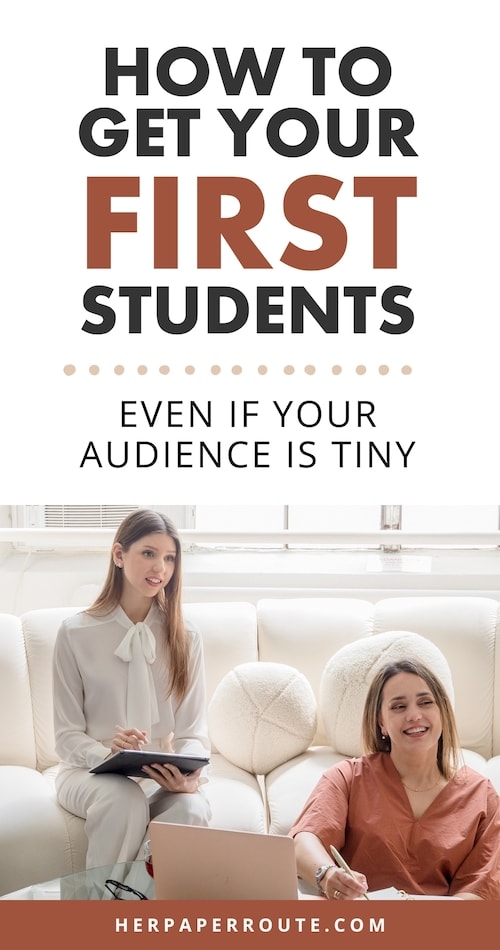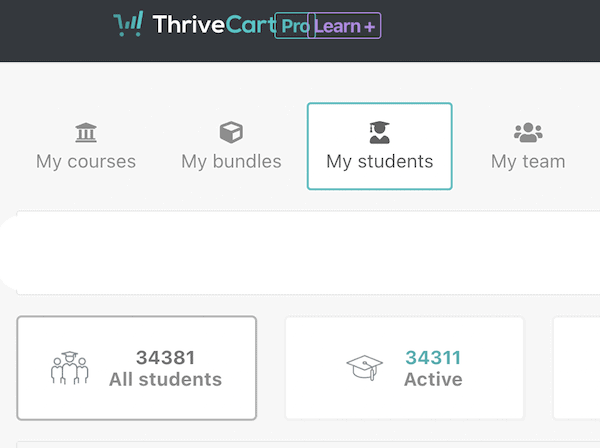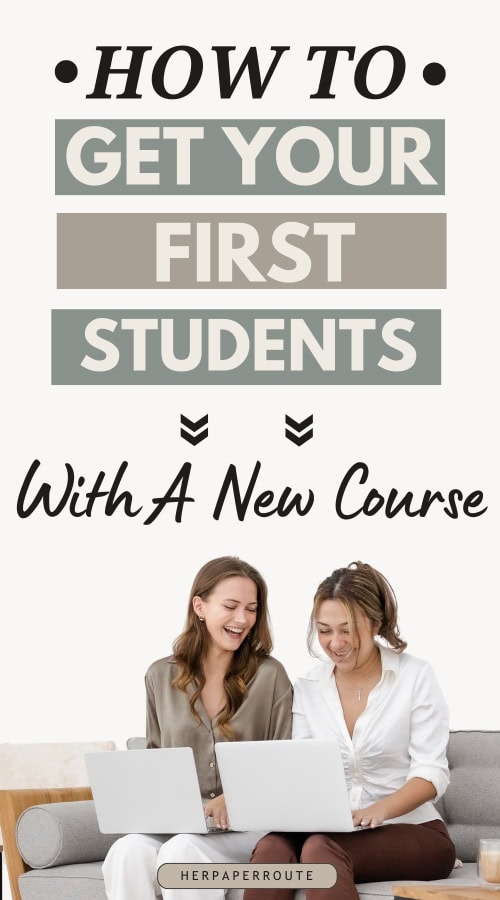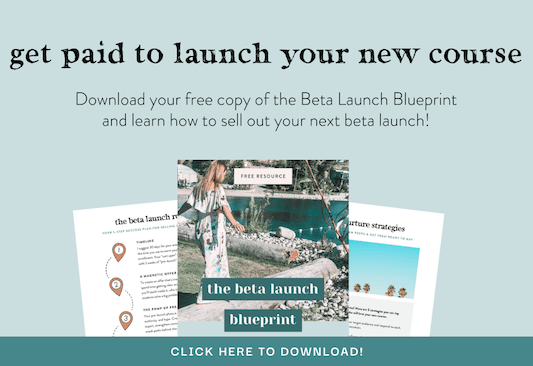How to Get Your First Students With A New Course

You’re ready to create your first course, but you’re wondering how to get your first students.
I can help you! The worry that your audience is too small or that no one will enroll is causing you to delay your launch and we need to solve that.
As an affiliate partner of various brands and sponsored content, HerPaperRoute may earn commission on qualifying purchases. Disclaimer
In this guide, you will learn a solid strategy for how to use beta launches to pre-sell your course and pre-qualify leads so that your course will be successful, no matter your list size.
So, let’s chat about how to successfully launch a new course and get your first students, even if your audience is teeny-tiny.

How to Get Your First Students, even if you have a small audience
If you are unsure of how to get your first students enrolled in your new course, and your audience is small, listen up!
Don’t let your small audience woes halt you from launching.
In fact, launching your first course to a small audience is awesome! When only a few people are watching you, you can host your first launch without any pressure at all.
When you have 100,000 people on your list in the future, there’s more pressure to ‘get it right.’
So appreciate that you can figure out your first launch, test things, and make ‘mistakes’ with only a few people watching, now while you can.
Here’s the thing: you’re not only doing yourself a huge disservice by not launching your course, but you’re also doing your audience a big disservice as well.
Your people desperately need the help you can give them, after all.
I have been offering digital courses since 2017.
Currently, I have over 34,000 active students – which is mind-boggling to me, considering I run my company as a solopreneur from my couch!

More recently, I opened a high-touch group program, as well as 1:1 in-person VIP weekends.
When I launched my very first course in 2017, only 10 people enrolled. But I was stoked because that was actually a pretty good conversion rate, considering I only had about 300 people on my email list.
They say the industry standard conversion rate for email subscribers to buy a program is about 2%.
So knowing this, I knew that if I wanted to enroll more students, I had to focus on growing my list.
And I’m glad I did! Building a community around my brand has been the #1 thing that has directly brought in sales.
And I am happy that only a handful of people saw my first course, as it allowed me to learn, make mistakes, and hone my skills in near privacy 🙂
I still have a fairly small email list, it’s under 40,000 subscribers nowadays. But they are people who are highly engaged in my brand and niche.
Becoming A Course Launch Pro
Over the years I have become a pro at launching. Specifically, I’ve mastered the low-key, low-stress launch.
I don’t do any big salesy hoobalah when launching.
I just follow a very streamlined process that educates my audience about my topic.
And I have pretty much every step organized into templates and a sales funnel that I simply customize and reuse each time. It’s very relaxed.
Here’s a screenshot of my Thrivecart dashboard showing how many course sales I had last year:

As you can see, the 3 spikes were when I had a launch. In February and August, I hosted a workshop and launched a course.
In May I hosted a virtual conference which was a re-launch of an old course, which saw our biggest conversion of the year.
Passive sale income (sales generated without a launch or event) stayed consistent throughout the year and then petered off in the Winter as I geared up for re-launching my program in the new year.
If you’d like to copy my exact launch system and sales funnel, you can learn all about it here.
What Type of Online Course should you create?
Do you ever have these thoughts:
- My audience is pretty small… what if no one buys?
- How can I build up hype for the course when I don’t have a lot of followers yet?
- Should I still do a big launch for my course even though it’s brand-new?
I hear these things all the time from my audience!
Today, I want to clarify and address these questions and worries.
Before we dig in, I have to say this:
If you have a small audience, I recommend creating an intimate, high-ticket, program.
For example, this might be a $5,000 signature program with limited spots available vs. a $49 course with unlimited spots.
You will make more sales of a $49 course than of a $1,000 program, but honestly, the conversion rates won’t be that different. Maybe 1% vs. 2%.
And if you do the math based on your audience size, you’ll see that you’re going to make a heck of a lot more money launching a $5,000 program or a $1,000 program, than a $49 one.
Plus, you can always create a low-ticket course for your next offer.
Start with the big high-ticket program to get some immediate cash flow.
Best Strategies For How to Get Your First Students Enrolled In Your New Course
For your first course, a low-key beta launch will be your best friend.
I never recommend going in full-force, guns-blazing, for your very first launch of a new course.
In other words, you do NOT need to send 10 emails, host 4 webinars, run a free 5-day challenge, or do 8 live videos during your very first launch (so breathe a sigh of relief).
In fact, please don’t! That’s only going to stress you out, overwhelm your audience, and possibly lead to burnout.
Instead, here’s how to execute a chill, minimal-stress beta launch to get your first students in the door.
1. Pre-Sell Your Course
Pre-selling is when you launch your course and accept new students before you actually create the course content.
This is also called a “beta launch.”
This is the best way to validate your course topic, messaging, and pricing.
I’ve talked in detail about the benefits of pre-selling before, so please refer back to this blog post if you want to learn more about how pre-selling works and why it’s the only way I recommend launching a new course.
But just so we’re all on the same page, know that you don’t have to create your entire course (or any of it, really) before you execute your beta launch.
You can launch with just one lesson, and then deliver each new lesson as you go, or live with the first group over a few months.
Download our free guide to setting up a Beta Launch:
2. Your course topic needs to be in-demand
Don’t create a course you think your audience wants. Create a course you know they want.
How can you be sure? Well, you can:
a) Ask your audience (simple, but hey, it works)
b) Look at other popular courses in your niche to see where the demand is
c) Think of the most common questions you get asked or the biggest struggles you see your audience having
Too many new course creators choose a course topic based on something they’re passionate about, without considering what their audience actually wants and is asking for.
This can lead to a failed launch, so don’t make that mistake!
3. Execute a micro pre-launch
The “pre-launch” is the period leading up to your launch when you’re building hype for your course, educating your audience, and establishing the need for what you have to offer.
For a regular non-beta launch, I recommend having a pre-launch period of 30 days.
But for your beta launch, I suggest chopping that in half and going with 14 days max.
Why? Because remember, you’re pre-selling your course to validate the topic, messaging, and pricing.
There’s still a chance that nobody will buy, and as much as that sucks to hear, it’s actually great intel for you moving forward.
But if you spend 30 days on your pre-launch and then a couple of weeks on the launch itself, only to wind up with zero customers… that’s 6 weeks of dedicated promo time that was essentially wasted.
Not really, but you know what I mean!
This is why we shorten the pre-launch period to 1-2 weeks for your beta launch.
The whole idea of a beta launch is for it to be low-key, chill, and short & sweet.
With that said, here are a few things you can do in your pre-launch to get your audience ready to buy:
1) Share your personal story and the results you’ve achieved
2) Talk about why you’re creating this course and how it’s going to help people (you do NOT have to keep your course a secret. In fact, don’t!
That’s one of 5 big mistakes to avoid when launching a new course
3) Share relevant success stories and testimonials from your clients
4. how long should a beta launch be?
This is totally up to you, but a general guideline is anywhere from 7 days to 3-4 weeks.
For a brand-new offer with a high-ticket price tag, a longer launch might work better.
This is because it may take your audience a bit of extra time to warm up to the idea of spending that kind of money on your course.
5. send juicy Launch Emails
As I mentioned earlier, you don’t have to send a bajillion emails to your list during a beta launch.
You also don’t need to have a ton of fancy bonuses.
Cut out all the bells and whistles and stick to sharing the main offer (your course) and how it’s going to help people.
I suggest sending 3-4 emails during your beta launch. In these emails, you should:
- Explain what the course is about and who it’s for
- Overcome objections your audience may have about joining
- Instill urgency by letting people know why NOW is the best time to join (e.g., the price is going up, getting people to “think about where you could be 6 months from now”, etc.)
- Remind them of the closing date* or the date the price increases.
If your program will be evergreen (open for enrollment t all times) then you won’t need a closing (cart closed) date.
I give my students copies of all of my sales funnel emails. So they can copy and paste my exact sales strategy and selling psychology into their launches.
6. Share the course on social media
You can literally talk about your course every single day on social media if you want to.
Just don’t say the same thing over and over again or you risk sounding like a robot.
Here are a few ways to mix it up:
- Welcome new students who join your course
- Talk about your inspiration for creating it
- Share your personal story and results
- Share case studies and testimonials from your clients
- Host a F.A.Q. session about the course
- Show behind-the-scenes peeks as you’re creating the course content
7. Send personal invites to the hottest leads
Sending personal invites for your beta launch can be your golden ticket.
Selling in the DMs (especially sending personal voice recordings in the DMs) can be very effective.
In fact, my student Krista says “I reached out to a handful of hot leads with an Instagram DM during my recent launch, and those conversations ended up resulting in TEN new customers out of 14 sales in total for my launch!!”
That’s an insane conversion rate! And it just goes to show the power of a personal touch.
With that said, there’s a right way and a wrong way to go about this…
❌ DON’T reach out to people you’ve never spoken with before.
✅ DO send messages to a small handful of carefully-selected people who you’ve already built a relationship with.
❌ DON’T be pushy or put any pressure on them.
✅ DO express why you reached out and why you think they’d be a perfect fit for your course.
❌ DON’T send the same automated message to every single person.
✅ DO be warm, inviting, and personalize your messages.
Good to know: These messages can be sent in whatever way you’ve communicated with those people in the past—whether that’s via email, social media DMs, voice memos, etc.
How to Get Your First Students, even if you have a small audience – Conclusion
And there you have it! That’s the basic explanation for how to execute a chill, low-key beta launch to get your first students.
Now that you understand the concept, it’s time to learn the strategy and actually put the prices together.
For this, I invite you to enroll in Sales Funnel Solved, it is your complete launch in a box.
It is the training where I reveal my entire sales funnel building stratgey and give you all my blueprints!
When you unlock Sales Funnel Solved for your business, you will:
- Gain expertise in understanding your audience’s desires and needs, as well as their willingness to pay for your offerings.
- Learn how to grow your business by effectively utilizing passive income streams through informative digital products.
- Establish yourself as an expert who can solve your audience’s problems and concerns.
- Develop your own sales funnels that are optimized for conversion.
- Craft compelling sales pages that effectively convey your message.
- Master the art of strategic pricing to trigger positive responses in your audience’s minds and wallets.
- Discover effective strategies for monetizing your digital products beyond the initial purchase.
- And more!


Follow along on Instagram!











